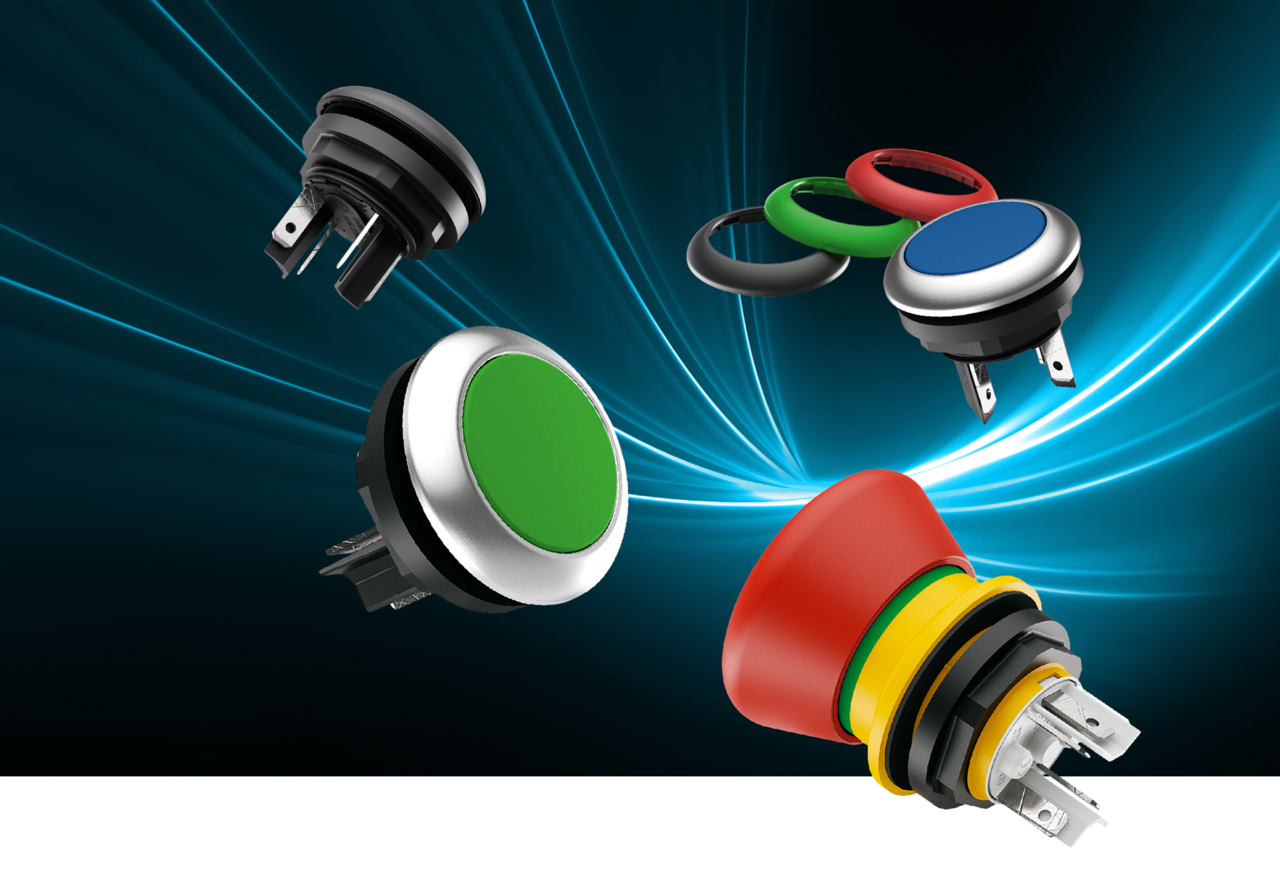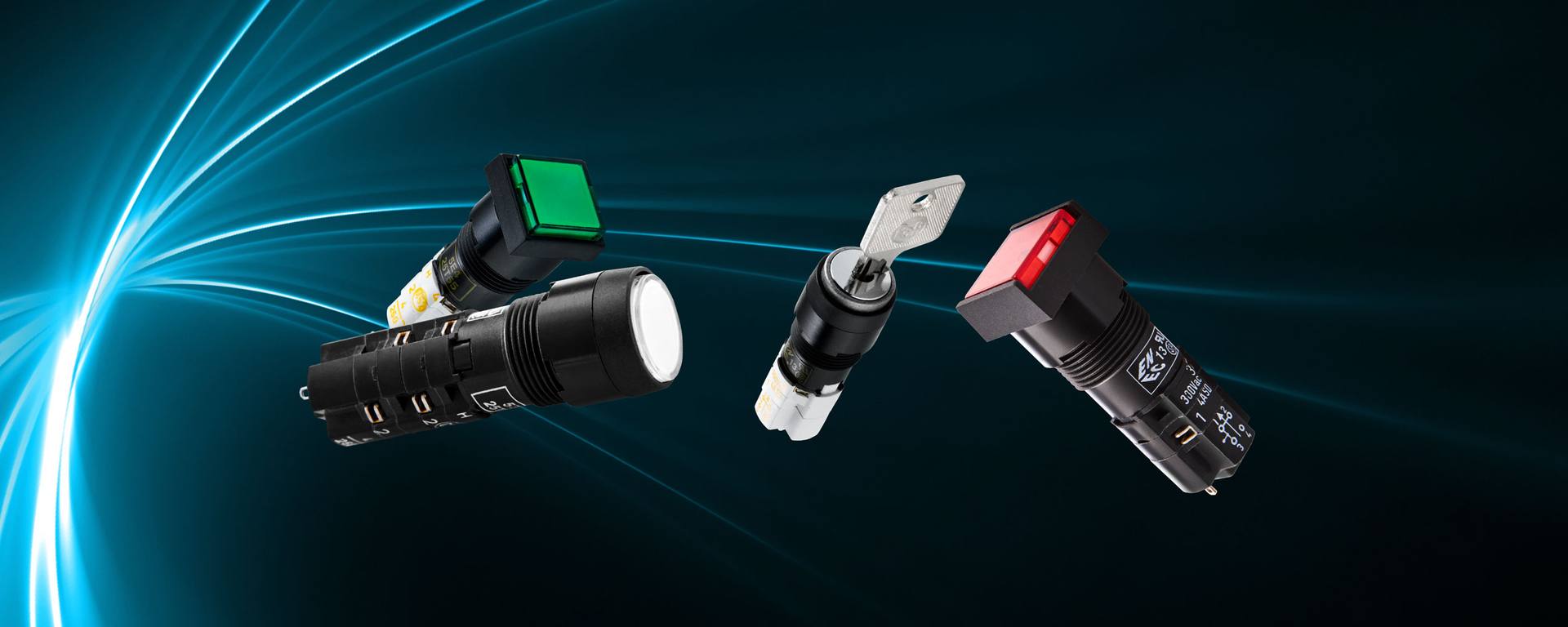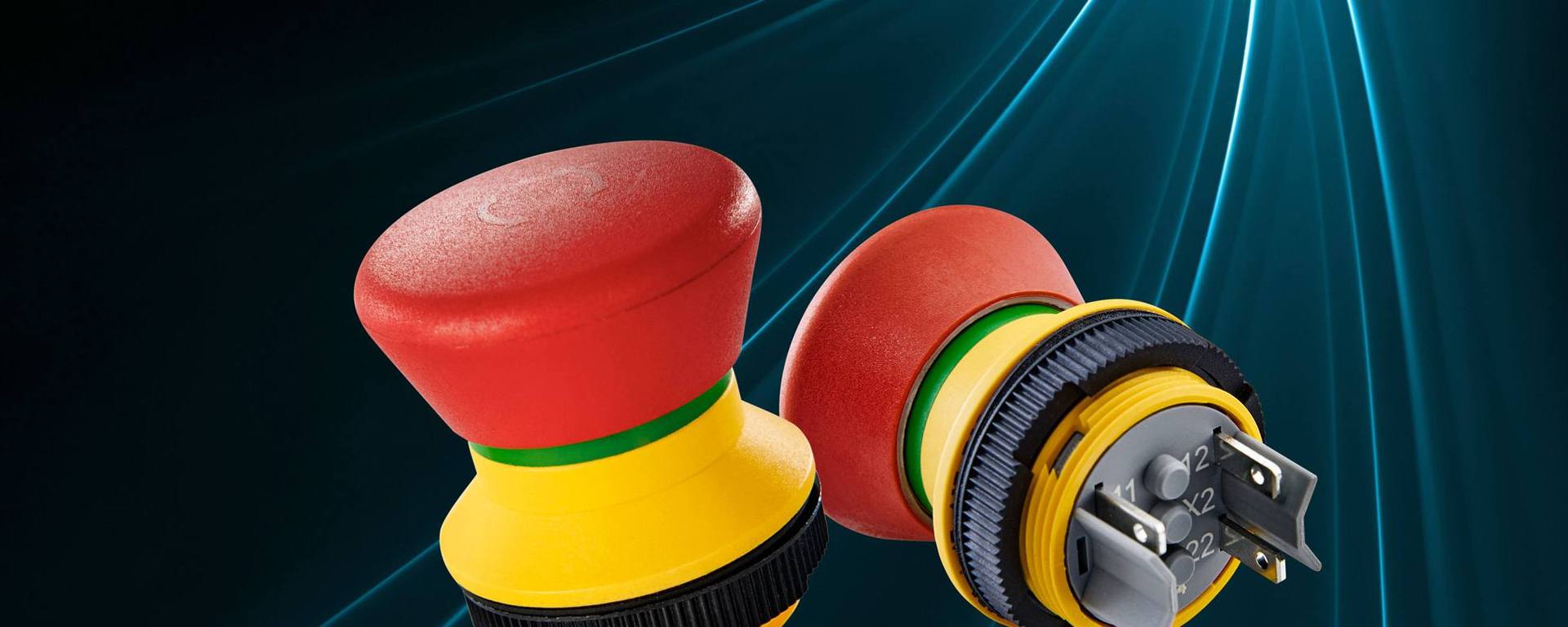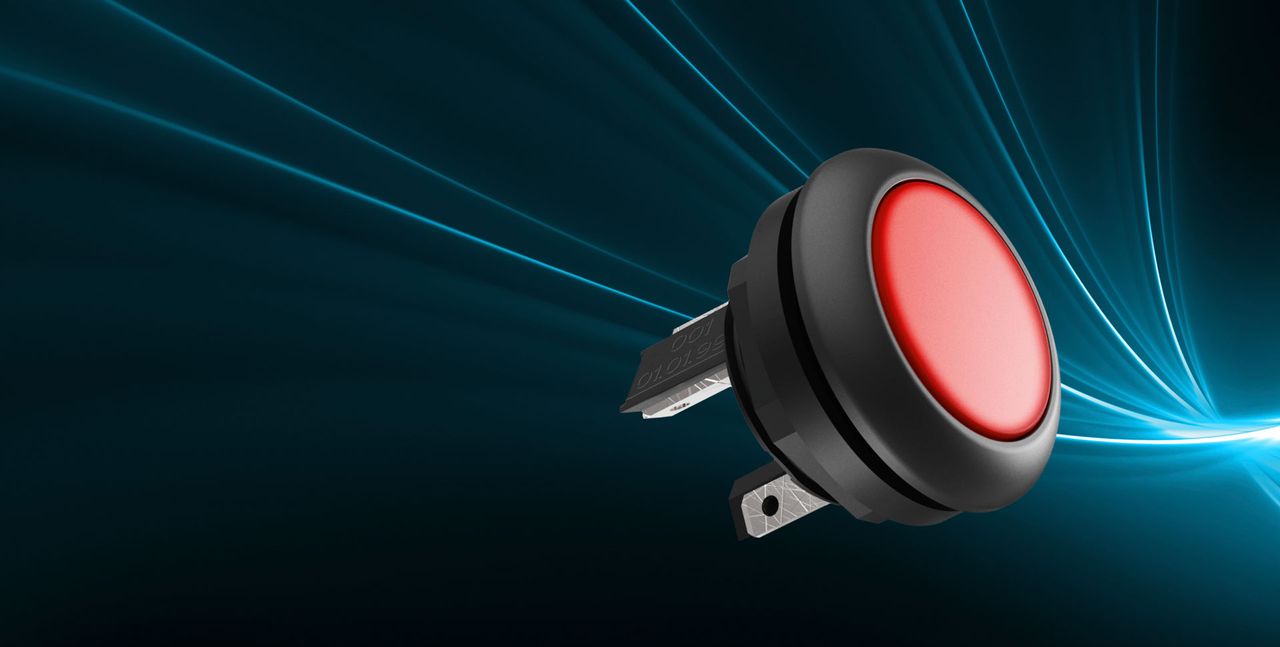From extremely compact to extremely practice proven – the LUMOTAST series will impress you with its simple assembly and single part housing. The LUMOTAST 16, for example, is designed for use in compact hand-held control units, the LUMOTAST 75 has always been popular with its full-surface illumination, and the LUMOTAST 22 emergency stop is used wherever space is at a premium – in front of or behind the front panel.
In addition to the LUMOTAST series, this page is also dedicated to the topic of “pushbuttons and switches” themselves. Two terms which do not mean the same thing. Switches are not the same thing as pushbuttons, and not all pushbuttons are pushbutton switches. We explain the main differences, advantages, types and applications further down this page.

LUMOTAST 16 pushbuttons are compact and switch reliably thanks to gold/silver contacts. LUMOTAST 16 is used in automation as well as machine and device construction, especially in hand-held controls. The pushbuttons are attached using a threaded ring in a 16.2 mm mounting hole. Completely new: the EMERGENCY STOP active/inactive for handheld controls used with a stationary unit.

LUMOTAST 75 illuminated pushbuttons and signal lamps have been in use for decades and are the most successful single pushbuttons in RAFI history. The wide range of collar shapes in classic design and the established terminal and legending concept make the LUMOTAST 75 series one of your most reliable components. Keylock switches compatible with the design are also available. The basic version of the LUMOTAST 75 provides IP40 degree of protection as standard. Pushbuttons and signal lamps are also available with IP65 degree of protection according to DIN standard. They come with a 2.5 mm higher collar due to the additional seal.

The extremely compact LUMOTAST 22 emergency stop with quick-connect terminals is ideal wherever an emergency stop or emergency power off is required and space is tight in front of or behind the front panel. The emergency stop is also available with a PCB terminal, see RAFIX 22 FS+ control component program.
RAFI pushbuttons and switches are ideal for applications in mechanical engineering, signaling systems, and measurement & control technologies. They are rugged, resistant to environmental conditions, and compact – with integrated terminals. The LUMOTAST and RAMO series are constructed as single pushbuttons. That means the actuator and switching element are permanently connected inside the housing. The advantage: low risk of confusion when connecting. Basically, the distinctions between pushbuttons and switches are their connection options and mounting holes from 9.1 mm to 30.3 mm.
Both pushbuttons and switches are actuated to allow a controlled flow of electricity. A switch remains in its position after being actuated. A pushbutton in contrast springs back into its initial position and is therefore just an initiator. So the difference is purely in the mechanism they are both based on. Visually, such a difference is often not discernible.
Which is where we come to the third term: the pushbutton switch. This would be the correct term for what is colloquially referred to as a button. But we will stick to the following system as we go on: The switch retains its position after being pressed, the pushbutton jumps back again.
A switch provides or disconnects an electrical bridge between two connections using conductive materials. It is usually manually actuated, i.e. by hand. The physical pressure of the finger on the light switch, for example, creates an electrical link between the conductive connections within the housing. This turns the light on in the room. The subsequent pressure disconnects the connection and the current flow again, the light goes out. Colloquially, this is sometimes also referred to as an on-off switch. The most common switch types are toggle switches, slide switches, rotary switches, selector switches and keylock switches. We explain what distinguishes these switches in detail at the end of the article.
However, actuation by means of force is only one form among many. Switches can also be switched by other conditions. In addition to switches that are magnetically actuated (reed contact), some require a flow of current (relay) and still others a change of position (liquid switch) or temperature (bimetal). As with almost every item, there are big differences in price. Some brands are cheap, but often not as reliable as the quality suppliers. Here it is important to weigh up which factor is decisive for the right choice.
... MoreThe pushbutton in detail
As explained above, a pushbutton is not a switch because it does not actively close the circuit, but only gives the impulse for it. (If we are very precise, a pushbutton also closes an electric circuit, just not the one to move an actuator, but a so-called control circuit, which in turn triggers the impulse for the actuator). The doorbell is a well-known example of a pushbutton. If an illuminant is also installed in a pushbutton, for example an LED, it is called an illuminated pushbutton.
Pushbuttons and switches are not only available as normally-open contacts, but also as normally-closed contacts and change-over contacts. As normally-open contacts, they are responsible for closing circuits – but only as long as the button or switch is pressed. If the pushbutton or switch is used as a normally-closed contact, actuation interrupts the previously closed circuit. A well-known application example is the motion detector. Some pushbuttons or switches have a change-over function. They can handle both of the two types: they can make as well as break circuits.
The pushbutton switch in detail
The pushbutton switch is an actuator that is activated by pressing and deactivated by releasing as described above. This creates an electrical connection that breaks again when the pushbutton switch is released. A spring is installed inside, which takes up the old position when actuated. Without it, the pushbutton switch would not work.
Example applications of pushbuttons and switches
Buttons and switches are ever-present in everyday life: doorbells, light switches, and computers are operated with their help. For example, the roller shutter of the underground car park starts moving because we press the radio remote control or turn the keylock switch. But switches, pushbuttons and control devices can also be found everywhere in an industrial environment. Although many human machine interfaces now focus on touchscreens, pushbuttons or, more rarely, toggle switches are almost always needed in addition to enable completely safe and intuitive operation.
Pushbuttons and switches from RAFI are used industrially for example in mechanical engineering, signal construction, measurement and control technology, medical technology, vehicle technology and automotive, but are also found in the consumer sector for coffee machines or WiFi routers. The most important thing is that our pushbuttons, switches, and control devices are worth their price. They are insensitive to environmental conditions and compact in size. Basically, the distinctions between pushbuttons and switches are their connection options, sizes, and mounting holes. We would now like to discuss a few of the countless variants and articles.
Tactile switches
Tactile switches are among the smallest mechanically operated pushbuttons. In just a few square millimeters of space, they ensure flawless switching. Due to their small size, tactile switches such as the MICON 5 and the RACON and RF series from RAFI are often used in devices with limited space: radio remote controls, car keys, valves or ATMs. They are often also part of entire keypads or are used in the form of membrane keyboards. In addition, tactile switches can be installed completely under the front panel and thus optimally integrated into individual user interfaces. Different plungers and keycaps also enable different actuating forces and customized designs to be realized. This connection makes RAFI products a safe choice. On the one hand, the price is right, on the other hand, the high-quality gold contacts in combination with the unique tactility ensure long-lasting safety when switching.
Emergency stop
Everyone is familiar with the emergency stop switch, usually just referred to as emergency stop. The actual technical term here is latching switch, determined by the underlying mechanism. The operator presses the switch in, usually firmly. In this position, the latching switch is then mechanically fixed and the circuit closed. These switches are required by law for machines and systems in industrial environments. There they ensure the safety of the employees during operations. If the machine has to be stopped quickly to prevent injury or damage, hitting the emergency stop does the job. The machine then immediately stops. The now closed circuit sends an impulse to the machine control system, which stops the machine immediately without it continuing to run.
This is the difference between an emergency stop switch and an emergency power off switch, which contrary to popular understanding, does not have the same function. The emergency power off switch interrupts the power supply of the entire machine. The switch acts as a breaker. As a result, the machine does not remain in its current position, but may continue to run its mechanical processes for a short time. For this reason, almost all modern machines are only fitted with emergency stop actuators, as they can guarantee a higher level of safety. The reset for each of the two variants, emergency stop and emergency power off, works in the same way, by turning the so-called mushroom, which, according to the regulations, is a red cap on a yellow background.
... Less
Switches make or break the circuit and then stay in position. Buttons make or break the circuit briefly and then spring back into their initial position. When looking for the right item, whether pushbutton or switch, remember that functions and reliability are usually more important than the price. High-quality products pay for themselves over time. This is expressed as the total cost of ownership.